Given a polygon, created entirely from rectangles, and defined by an array of points, where the edges are always aligned with the axis:

I am trying to determine a quick algorithm to find a small number of rectangles which can fill in this shape. This is something I did by hand to show the collection of rectangles I am describing:
EDIT: Here is some simple processing code to create this shape (well, close to it).
float[] xpts = {0, 50, 50, 100, 100, 150, 150, 250, 250, 300, 300, 325, 325, 300, 300, 250, 250, 210, 210, 250, 250, 125, 125, 25, 25, 50, 50, 0 };
float[] ypts = {100, 100, 80, 80, 10, 10, 80, 80, 75, 75, 80, 80, 200, 200, 300, 300, 275, 275, 260, 260, 200, 200, 270, 270, 165, 165, 125, 125};
void setup( )
{
size( 350, 350 );
}
void draw( )
{
stroke( 0 );
strokeWeight( 1.5 );
float px = xpts[0];
float py = ypts[0];
for (int i=1; i < xpts.length; i++)
{
float nx = xpts[i];
float ny = ypts[i];
line( px, py, nx, ny );
px = xpts[i];
py = ypts[i];
}
float nx = xpts[0];
float ny = ypts[0];
line( px, py, nx, ny );
}
